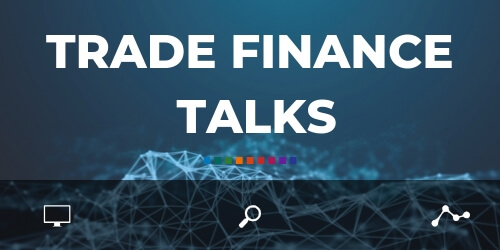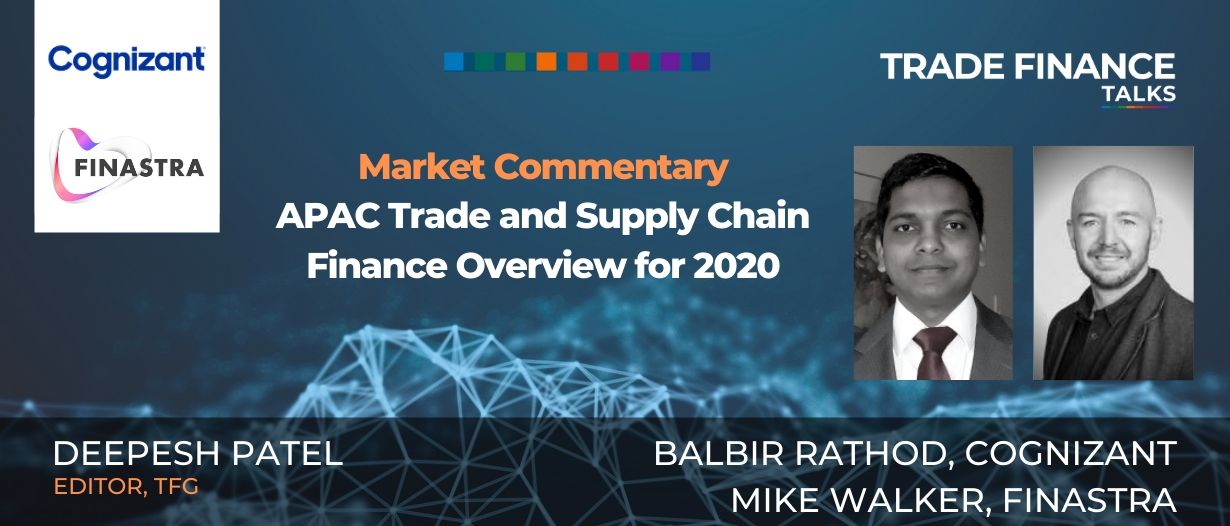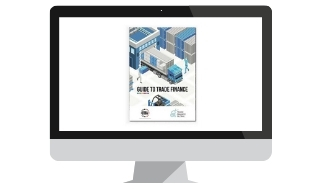Listen to this podcast on Spotify, Apple Podcasts, Podbean, Podtail, ListenNotes, TuneIn, PodChaser
Season 1, Episode 38
Host: Deepesh Patel (DP), Editor, Trade Finance Global
Featuring:
Michael Walker (MW), Head of Working Capital Finance, Finastra
Balbir Rathod (BR), Senior Manager Consulting, Cognizant

Today’s podcast is all about Asian trade flows and their expected growth, which is predicted to be between 4-9%, according to the ICC. A leader on the world stage, Asia produces, trades and consumes over two-thirds of major commodities. The region is on track to top half of global GDP and 40% of the world’s consumption by 2040. $900 billion of the $1.5 trillion USD trade finance gap stems from underfinanced businesses in Asia, yet promising developments around regional free trade agreements and the delivery of innovative technology born out of the APAC region is undeniable.
Deepesh Patel (DP): Today I’m joined by Michael Walker, Head of Working Capital Finance, Finastra and Balbir Rathod, Senior Manager Consulting, Cognizant, joining us from Singapore, discussing the good, the bad and the ugly of Asia’s working capital finance landscape from three lenses; trade, regulation and technology. Can you both introduce yourselves?
Balbir Rathod: Thanks, Deepesh. I’m Balbir, Senior Manager Consulting at Cognizant, with 15+ years of experience covering payments, cash management, trade and compliance. In my role, I predominantly advise banks and financial institutions around business transformation, technology and digitalisation.
Michael Walker: My name’s Michael Walker, I’m Head of Working Capital Finance for the Asia Pacific region at Finastra. So, I’m responsible for everything trade and supply chain finance across this huge region.
Market update: trade and supply chain finance in 2020
DP: 2020 hasn’t really shown any signs of slowing down in terms of geopolitical uncertainty and market volatilities, not to mention the outbreak of coronavirus. Michael, what have been the biggest themes in trade, receivables and supply chain finance from an APAC perspective in the last few months?
MW: So I think certainly the coronavirus situation is an interesting one to start with because it’s highlighted the dependency of global companies on supply chains that are anchored in China. Considering China joined the World Trade Organisation in just 2001, it is now the world’s largest exporter and second-largest importer. So it’s hugely important to the overall trade dynamic. This situation itself has highlighted that dependency and potentially shows the lack of flexibility and being able to redirect flows and orders. To date, we have seen stock markets reaching record lows since 2008, and now a prediction for growth slowing considerably. So certainly, that’s been one of the big themes of the last few months.
The second theme I’ve seen is new initiatives along with the emerging consortia / networks, centred around government backing and single trade windows. In particular we’ve seen the active involvement of the ICC in standards and process definition, through the Digital Standards Initiative, which was previously the Universal Trade Network. The creation of the ICC ‘Trade Flow’ platform and the announcement at Davos around the collaboration between the Singaporean Government, the ICC, and 17 global companies and financial institutions on ‘Trade Trust’, the legal framework, designed to facilitate the adoption of digital technology and trade. We’re also seeing trade agreements focused on digital trade specifically – between Singapore and Chile and New Zealand – those have already been ratified whilst negotiations with Australia are at an advanced stage.
The third area I think we’re seeing as an emerging theme and a continued theme is around sustainability in practice. Banks no longer financing coal power plants, for example, and are looking to use the evidence of goods provenance to provide finance. Technology such as DLT and blockchain is reducing the cost of monitoring these sustainable initiatives.
This is coupled with industry bodies such as the ICC, BAFT, and the ESG focussed rating agencies driving the standardisation of practices and frameworks. I think one challenge we do have though is that developing countries carry the greatest share of carbon emissions, yet reducing those emissions could result in an increased poverty rate due to dependency on those industries. It’s very much a balancing act in that respect.

Changes in trade in China
DP: Are these themes all coming from China?
BR: There are two sides to this. Firstly, the manufacturing and goods piece, secondly the services piece. China provides around two-thirds of goods across the globe; US and Europe are the predominant importers of Chinese goods. From a services perspective, it’s India, which is leading in this field.
One change more recently though, is the trade conflict between the US and China. We have seen that Southeast Asian corridors amongst themselves are increasing the trade, and as a result, they are reducing tariffs amongst themselves. So from a manufacturing perspective, there is a gradual shift happening. Supply chains are starting to rely on countries such as Vietnam and the Philippines to set up their manufacturing facilities. This is to mitigate the risk of a single point of concentration.
From a services perspective, India is a global leader of IT services exports. So to summarise, we’ve seen the world step away from a potential reliance on China, and as a result, a spread of manufacturing and services exports between India, China and Southeast countries. One pertinent statistic here around India and Vietnam – they’re predicted to become the 7th and 11th largest exporters globally in the very near future. So we’ll see a diversification of supply chains and as well as more free trade agreements underpinning those. This means that more players will take centre stage in the global trade market, which also means that many will need access to finance.

Corporates versus bank expectations in trade and supply chain finance
DP: Let’s talk about financing requirements. What are the corporates starting to ask for from their banks, when it comes to trade and SCF requirements, and are the banks delivering?
MW: So in some ways, the corporates’ requirements haven’t changed, and it ultimately comes down to faster turnaround times and lower pricing. But as you eluded to earlier when discussing the trade finance gap, a large number of corporates cannot get access to financing quickly enough due to the inability to complete ‘know your customer’ checks effectively and they have a lack of collateral. In general, we’re also seeing that corporates are asking for financing earlier in the lifecycle of their trading relationships, and this really is where the opportunity lies for fintech collaborations, given the greater availability of data coming into play.
So the likes of the collaboration between Standard Chartered and Linklogis in China to provide deep tier financing as one to certainly track the turnaround time flow pricing and access to finance generally, as well as earlier in the supply chain.
Another proposal raised by corporates to their banks is the idea of a consolidated platform across both traditional trade/ supply chain. The maturity of the counterparty relationships and the country itself they are doing business with will drive which product they use. Ultimately, corporates want a single view of their liquidity and the ability to manage their business in a consolidated way even if they are doing business with multiple banks. They want to maintain the flexibility to harness multiple challenges, channels and initiatives for transactions depending on the sector, region and product in play. However, from both a bank and corporate perspective it will be key to maintain a consistent process and operating model, regardless of the channel, network and technology used. This is really the only way to future-proof themselves as we see emerging technology and initiatives come to the forefront as we move further through the decade.
Regulatory hurdles
DP: From that bank perspective, what are the most significant regulatory changes being faced?
BR: Typically, KYC is a time-consuming process. For example, if Shell needed to open a relationship with Standard Chartered it is a timely process – roughly taking 3-6 months (depending on the product, the countries, how they manage their exposure etc). When you look at the same scenario with SME’s, it is significantly different. SME’s face multiple challenges with this: Data – when addressing KYC requirements, we don’t currently have a shareholding pattern, so unwrapping takes a longer time to find the ultimate parent. This can push the duration of the process of opening that relationship more toward 6-9 months. Taking into account that banks have been taking the approach of – if a client is a bit risky, they won’t on-board them. As a result, there are then two issues; first you are moving away from the business completely; and second, these clients then won’t have access. Instead, they will need to exert better arrangements, such as contacting non-banking financial corporations. With the digital platform coming up (like Lazada, for example), it is pretty much imminent that you will need to change the client evaluation process from a bank’s perspective. Here, we are really talking about some of the entities who are growing their business, 20-50% month on month, so what these customers need will be drastically different. Given the kind of stringent requirements and the working model, banks and financial institutions need to re-look at the market demand and tailor their solutions.
MW: I think, with the SME piece, it amazes me that they represent around 95% of the world’s companies, and 60% of the world’s private sector jobs (according to the ICC). They also generate around 75% of the world’s GDP, however over 70% of the SME financing requests will initially be rejected. Clearly there is a huge opportunity, particularly in this region around SME financing that’s current not being met from a financing perspective.

Alternative financiers and banks working with fintechs
DP: Thank you both very much. I think we’ve seen the rapid rise of alternative liquidity providers entering into the market, perhaps as a result of this increase in regulation and even the banks’ ability to innovate faster in order to serve the customer. I guess this leads onto my next question; should banks be worried about the rise of alternative finances? And should they be working with Fintechs more?
MW: So I think firstly, there is already a very significant Fintech and bank collaboration taking place in the market, and it will only continue to rise. Most major banks have their own Fintech arms in the form of incubators or Fintech hubs. Banks absolutely do want to work with Fintech, where I think their challenge will be is finding or onboarding, and verifying those solutions which they then have to deliver bespoke integration for and maintain over time. This is where (excuse the shameless plug from a Finastra side), open API platforms such as our own infusion fabric cloud is helping to take the emphasis away from banks in managing those Fintech partnerships and standardising integration via open API’s offering that flexibility and choice of solutions. Going back to the point around the rise of alternative finance providers – I think there’s several reasons for this.
One, is their ability to capture areas of the market that are simply unattainable for banks. Some of those platforms that we look at in China, they’re already supporting a huge number of businesses already – they have the relationships, the trust and the data available to them to be competitive in their offering. It is a small leap from there, to offering new services and new financing based on that data. Banks have simply not been able to reduce that barrier to entry for those who need to be financing most, nor have they been able to effectively digitalise at scale due to, in some parts their legacy processes and systems. I think those companies and new technology companies have the ability and the agility to offer next-generation services and experiences at speed. If you look at the experience we get in our retail life, vs. our professional life is a good example. If we look at the experience we get from Amazon or Google, or the experience I get through purchasing/ using my iPhone, that is not associated with my bank. From a retail perspective, it’s certainly not the experience I would have within a corporate bank today more often than not. In some respects, the Neo and challenge banks have shown that it’s actually quicker to build a digital-only bank from scratch, then have an existing bank pivot to new experiences and ways of conducting business. Ultimately, what we’re seeing is those platform companies collaborating with the bank. A big example of this would be Google working with the banks in India to provide digital lending and SME financing. Let’s not also forget that it is not just the traditional platform companies in other areas of the ecosystem for trade, that are offering finance as well. So Maersk, for example, have been offering trade finance since around 2017 and have dispersed about $700 million US to financing as of mid-2019, and they aimed to disperse a further $200 million of financing in India alone by the end of 2019. Maersk in particular are leveraging that position they have in the ecosystem and their role in that value chain to offer new services that will complete with banks.
Cost vs payoff in trade finance software
DP: Thank you, Michael. How can technology help here? Because there’s the obvious issue around the huge upfront costs and investment costs from a bank’s perspective to really enable some of these next generation services that the retail customers see on a regular basis. Balbir, how can we perhaps reduce the cost of supporting transactions and how can technology help that?
BR: Historically, we have seen there are 3 challenges which are associated with the supply chain finance/ trade finance industry. Firstly, we see there are islands created because of the multiple parties’ involvement. When we talk about the multi-parties, just to name a few – any trade transaction, you will have regulators involved from that country’s perspective, you will have shipping agencies etc. Then you will have financial institutions from originating party and the beneficiaries and potentially intermediaries. So there is a gamut of things involved in closing just a single transaction, and if the break happens anywhere, we see the integrated digital flow go away. From a technology perspective, historically we have seen some of the technologies like OCR, the digitisation of invoices and digital invoice generations – which are now being mandated across some countries. These kind of technology initiatives, along with the ‘New Age’ – Big data, blockchain, open API’s etc. Recently we have a rise in digital banking licences across the Asia Pacific, which Michael was just talking about. For example, Singapore is rolling out 5 digital bank licences, Malaysia is also rolling out some licences. Given that it’s not only that technology is an enabler in the industry, it is actually coming to the forefront of the industry and as a result of that, new product offerings will be needed, and the dynamics will all change. There will be no more silos that take care of just one industry. There will be horizontals or big giants like Amazon, who need end-to-end services and they offer anything under the sun.

Looking to the cloud(s)?
DP: As a bank looking to build on its current trade technologies, perhaps reinvent some of its legacy architecture, the banks need to think about a future proof solution that allows them to grow and also allows them to add new offerings on top of current products. As we know in trade finance, there’s a big cross-sell piece in terms of different product offerings, etc. etc. and being able to really tailor to specific needs. So, as a bank looking to feature new technologies into their back-office operations, what are the features that they should be looking at in terms of finding products and finding agile technologies to best serve their corporate customers, Michael?
MW: Again, I think there are several things that banks can do to ease the adoption of new technologies into their supply chain finance operations. One thing they absolutely should be doing is looking for flexibility and the ease of integration and ongoing maintenance. This market is still very dynamic, it’s very volatile and changing rapidly, so they need the ability to adapt to those market conditions and demand. Digitisation is ultimately nothing new in trade finance, the challenge however has always been around adoption and interoperability which created, what we now term as Digital Islands, we need to be looking at problems holistically, so we don’t just create new digital islands with new technologies. The Chinese banks often face the issue of being held back by inflexible systems and can’t really offer new products and services in a cost-effective way. Invariably, this can leave them at risk of losing relevance to their corporate clients and ultimately losing business to alternative finance providers that we’ve talked about, or to traditional competitors as well. I think also banks should look to effectively prioritise – take blockchain for example, its sexy right? Despite predictions that it will increase global trade volumes by $1.1 trillion by 2026, it’s not often associated with supply chain finance. Finastra are huge advocates of distributed ledger technology, but it’s not necessarily the panacea and certainly not in the short to medium term. We’re going to be living in this hybrid world of paper, digitised and digitalised for the foreseeable future because new business paradigms, new technologies, they take time to be adopted. This is where the likes of OCR and RPA technologies really can be integrated for quick wins from a bank’s perspective, because we know that 60% of costing relation to trade finance transactions is purely to do with compliance and checking of physical documents. That is a use case that is ripe for disruption when it comes to rapidly maturing OCR and RPA technologies. I think one element that’s often overlooked as well is the people issue. We focus on technology, and to a lesser extent the people that are still going to be within the business. It is widely acknowledged that there’s an upcoming trade finance gap from a talent perspective, and we’re not necessarily getting the number of people we need coming into the industry to fill that gap, and it’s something I’m hugely passionate about.

Future forecasts for trade in APAC
DP: Thanks very much, Michael. I guess to end, I want to pose a question to both of you which is fairly difficult given that within the past 6 weeks we’ve seen sweeping changes that have affected the global economy, but what are the most exciting opportunities coming out of APAC trading supply chain finance in your opinion?
BR: If we look at the opportunities which are coming out of APAC trade, first from a cross-border regulations perspective we are seeing more treaties being entered, so more cross-border business would happen. Second, with globalisation what we are seeing more manufacturing hubs outside of China, Thailand, Vietnam and Philippines companies are expanding bases. They are looking at banks and financial institutions to advise them not only about trade finance or having traditional products, but also what are the challenges and how they can set up business – more advisory services from the banks. Interestingly, in the last few weeks with the spread of Covid-19 we are seeing changes to supply chains. So companies are looking at coming up with different product mix, new products – some may be only available in one location and the aim is to spread across all geographies. Given that we are looking at financial services and banks widening their offerings and services, getting into advisory arenas, we see companies changing their product mix to address current situations.
MW: I’d echo what you just said, Balbir. I think with the continued growth of developing nations, the current SME financing gap presents a huge opportunity in this region. The consumption of goods in emerging markets has grown by about 50% in the last decade, and we’ve already referenced India and Vietnam and the position they’re going to have in the global trade and supply chain landscape in the coming years. I think we’ll continue to see sustainability and focus with upcoming generations that are willing to spend more on brands that are responsible and ethical. The challenge will be where do you draw the line. For example, banks not financing coal fired power plants, but would be happy to finance the shipments of coal to those power plants. It’s a bit like what they call the free-range egg problem – everyone knows free range eggs are more ethical than if they’re double the cost of regular hen eggs. You’re not allowed people to make ethical decisions, you’re forcing them down a financial decision. It is the same with sustainable trade in some situations currently. I think one thing is for certain – Asia will be the beating heart of global trade. More people and businesses from developing economies are coming into the real or official financial system, the growth of the middle class in those countries shows the continued growth between developing nations. As we say, with a continued emphasis on sustainable practices and the associated financing, I truly believe we can do well by doing good. I have no doubt that companies can work ethically, and sustainably whilst still growing.
DP: Michael, Balbir thank you very much for sharing your thoughts on some of the opportunities and challenges around trade and supply chain finance.
 Australia
Australia Hong Kong
Hong Kong Japan
Japan Singapore
Singapore United Arab Emirates
United Arab Emirates United States
United States France
France Germany
Germany Ireland
Ireland Netherlands
Netherlands United Kingdom
United Kingdom












Comments are closed.